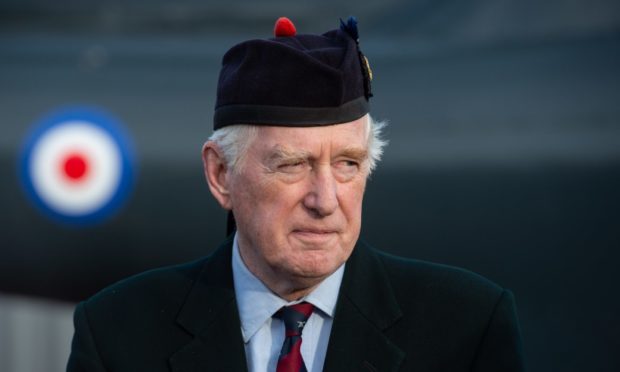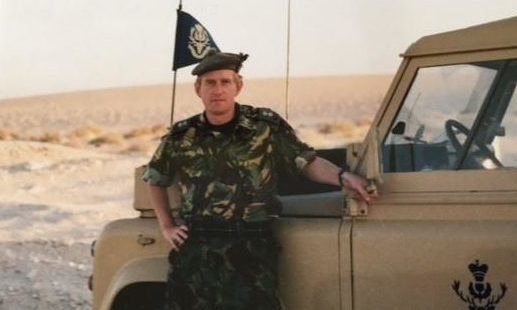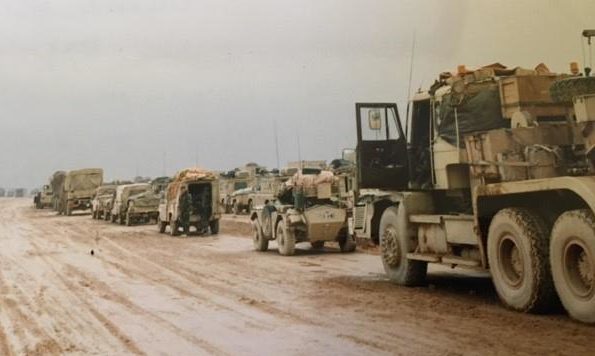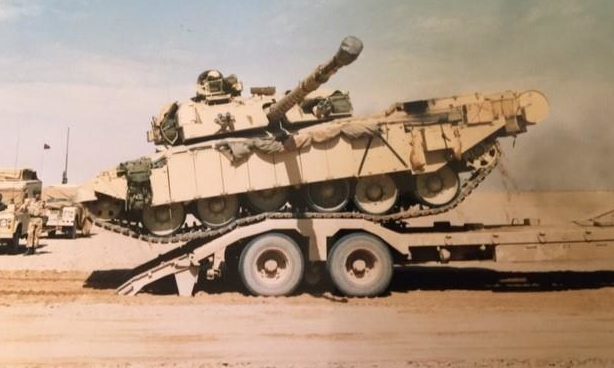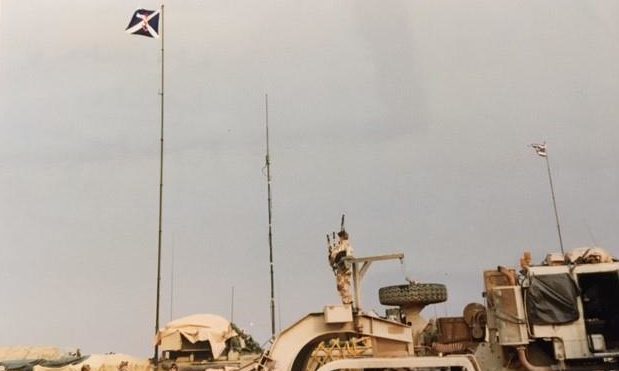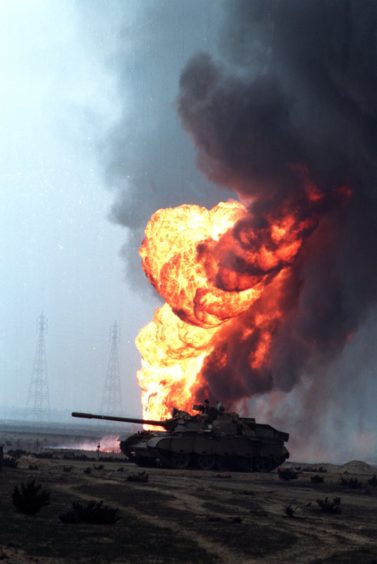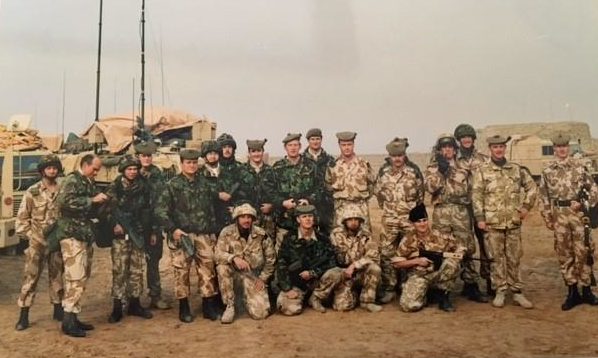The man who led a Highland regiment during the Gulf War has recalled the pride and tragedy of the desert battlefield 30 years on.
Major General Seymour Monro, 70, was the commanding officer of the Queen’s Own Highlanders (QOHLDRS) during a remarkable chapter in the regiment’s history.
On the very day Iraq’s President Saddam Hussein invaded Kuwait, the Highlanders had returned from an operational tour of West Belfast.
Fresh from their tour of duty, the highly-trained troops begged the then Colonel Monro to see service in the Gulf.
Maj Gen Monro said: “The Jocks, as we call them, kept saying ‘can we go to the Gulf, sir? When are we going?’”
But without the new Warrior armoured fighting vehicles, which were still being issued, it was unlikely the Highlanders stationed at Munster in Germany would be seeing combat.
False start
However in November 1990, tensions began to escalate in the Middle East.
The QOHLDRS’ regimental band was deployed in its secondary role of providing medical assistance, followed by 90 Highlanders to reinforce the Royal Scots and Royal Regiment of Fusiliers.
Then came the call from Divisional Commander Rupert Smith – all the troops were to mobilise, the moment the keen soldiers had been training for.
Maj Gen Monro said: “It was tremendous when we were told we were deploying.
“I’ve never seen vehicles painted from green to sand coloured quite so quickly.
“It was a measure of the Highland warrior, ready to fight.”
An advance party including Maj Gen Monro arrived in Saudi Arabia on December 11 ready to meet vehicles, armoury and equipment being shipped over from Germany.
But no sooner had they arrived when it was announced the battalion was ‘off orbat’ – they were no longer to be deployed.
“It was a ridiculous business,” said Maj Gen Monro.
“We were told to put all our vehicles into a storage compound.
“It was a pretty depressing moment, the battalion returned to Germany and went on Christmas leave. Most came back to Scotland.”
An eleventh hour call
A few weeks later, just minutes from midnight, while Scots were merrily celebrating Hogmanay and getting ready to ring in the new year, Maj Gen Monro received a phone call.
He said: “I was rung at about quarter to midnight on New Year’s Eve by the MOD duty officer who said ‘when can your battalion deploy to the Gulf, Colonel Monro?’
“I said ‘you must be joking, do you know what time it is?’
“’Ring me back in the morning!’ And I put the phone down.”
The Highlanders had seven days’ notice to get to the Gulf.
He said: “There was great excitement with using the television and radio to get everyone back from all over Scotland, back to Munster and ready to the Gulf on January 7.”
New territory
The battalion was split – B Company was sent to Riyadh, the capital of Saudi Arabia, while A company guarded the 1st Armoured Division.
Meanwhile the Highlanders’ Armoured Delivery Group (ADG) was to act as reserve for the attacking divisions, the 4th and 7th brigades desert rats.
At this point Maj Gen Monro and battalion headquarters had 1,200 men under their command, including tank squadrons, armoured vehicles, a battery of guns and rockets, as well as the whole of the British Army’s transporter fleet.
Just 10 days before the ground war started on February 24, it was found there was a shortage of tank transporters – the troops had to find innovative ways of mobilising -half the ADG went forward and the rest stayed behind.
Transporting the tanks saved their engines and made combat more efficient.
Maj Gen Monro said: “We had to practice loading tanks onto transporters and see if they could fire off the back of them. We could fire over the front, but if you fired from the side, the transporter tipped over.
“It was all quite exciting, it was completely new to most of us, it had never been tried in the British Army before having transporters going into battle with armoured fighting vehicles on the back.”
Prayers on the battlefield
The planning paid off on the day of the crucial advance.
The first to reach Kuwait was the Highlanders’ reconnaissance platoon and the Signals detachment, who were forward with the 1st Armoured Division.
After another three days of warfare the ceasefire was declared at 0800 hours local time, but tragedy had already struck.
Three Highlanders who had been reinforcements with the 3rd battalion the Royal Fusiliers were lost to friendly fire at the hands of the Americans.
They were Private Neil Donald, of Forres, Private Martin Ferguson, of Fort William, and Private John Lang of Nairn.
Maj Gen Monro said: “That was very, very sad news as you can imagine.
“A day later, just after the ceasefire, I managed to get a hold of our padre and we went up and we saw where this friendly fire accident had taken place.
“There were the destroyed armoured fighting vehicles, we said prayers and remembered the three of them.
“That was a really low point. We all said to ourselves ‘we’ve been really mucked about coming to the Gulf War, but we got ourselves organised and no sooner have we gone to war, we’ve crossed into Kuwait and three of our fellow Highlanders have been killed in a friendly fire incident’.”
The Highway of Death
Another harrowing memory that will never leave Maj Gen Monro was witnessing the aftermath of a barbaric act of bombing retreating Iraqis escaping Kuwait after the ceasefire.
A three-mile convoy of vehicles was targeted and obliterated in a continuous bombardment by American jets. It became known as the Highway of Death.
He said: “We saw the awful horrors on the road to Basra where columns of Kuwaiti vehicles, both civilian and military, had been stolen by the Iraqi forces and they were retreating from Kuwait.
“They all had men inside them and had been completely taken out by the American Air Force – it was just a ghastly sight.
“And I remember remarking to Robin Coles, who was commanding A Company, saying ‘war is awful and we really must – all of us, all nations – do what we can to avoid it in the future at all costs. Nothing is worth what we see here. It’s just too ghastly’.”
Amidst the sadness and relief that the battle was over, the battalion gathered and carefully withdrew, returning to Germany by early April.
The war was over.
In the space of just six weeks the troops had deployed, fought a war and returned home.
A family regiment
But 30 years on, the losses are still keenly felt and the pride for a brave battalion who had to adapt quickly to desert conditions has never subsided.
Nor has the kindness of the families and communities back home been forgotten.
Maj Gen Monro said: “We remember the three soldiers and our thoughts and prayers are with the family at this time, and those that were injured in that friendly fire incident as well.
“We soldiers were supported so well by our families left behind in Munster and indeed all the families across the Highlands and Moray who used to send us lots of letters – blueys as they were called – and parcels out to the Gulf.
“We’ve always said we’re a great family regiment, there were lots of families serving together.
“Pte Lang’s father was out there and Pte Ferguson’s twin brother Clark was serving with B Company when his brother was killed a few miles ahead of him.
“Pte Lang was Sergeant Keith Lang’s son, while Pte Donald’s younger brother was in training with the Junior Infantry Battalion.
“There were lots of brothers serving and lots of sons of fathers who’d served. We were like a clan, a very tight-knit regiment.”
Battle Honour
The tenacity and bravery of his soldiers during the conflict still resonates with Maj Gen Monro to this day, and their performance is one of the stand-out moments of his military career, which began at Sandhurst in 1968.
He said: “Most people who have a military career aspire to be commanding officer of their regiment and so to achieve that was very special to me.
“To command a battalion of operations in Belfast and the Gulf War was particularly memorable.
“We were proud to be part of it, the Jocks would have been furious to be left out of battle, they were screaming to go saying ‘we’re the best infantry in the British Army – we need to be there’.
“There is a very strong bond between everybody who served, because we enjoyed our soldiering and we were good at it.
“We were awarded the Battle Honour of the Gulf, which is the only battle honour the QOHLDRS has, because sadly it had been amalgamated in 1961.
“It had always done well in operations and was considered one of the very best in the British Army, so we were very proud of that.”
